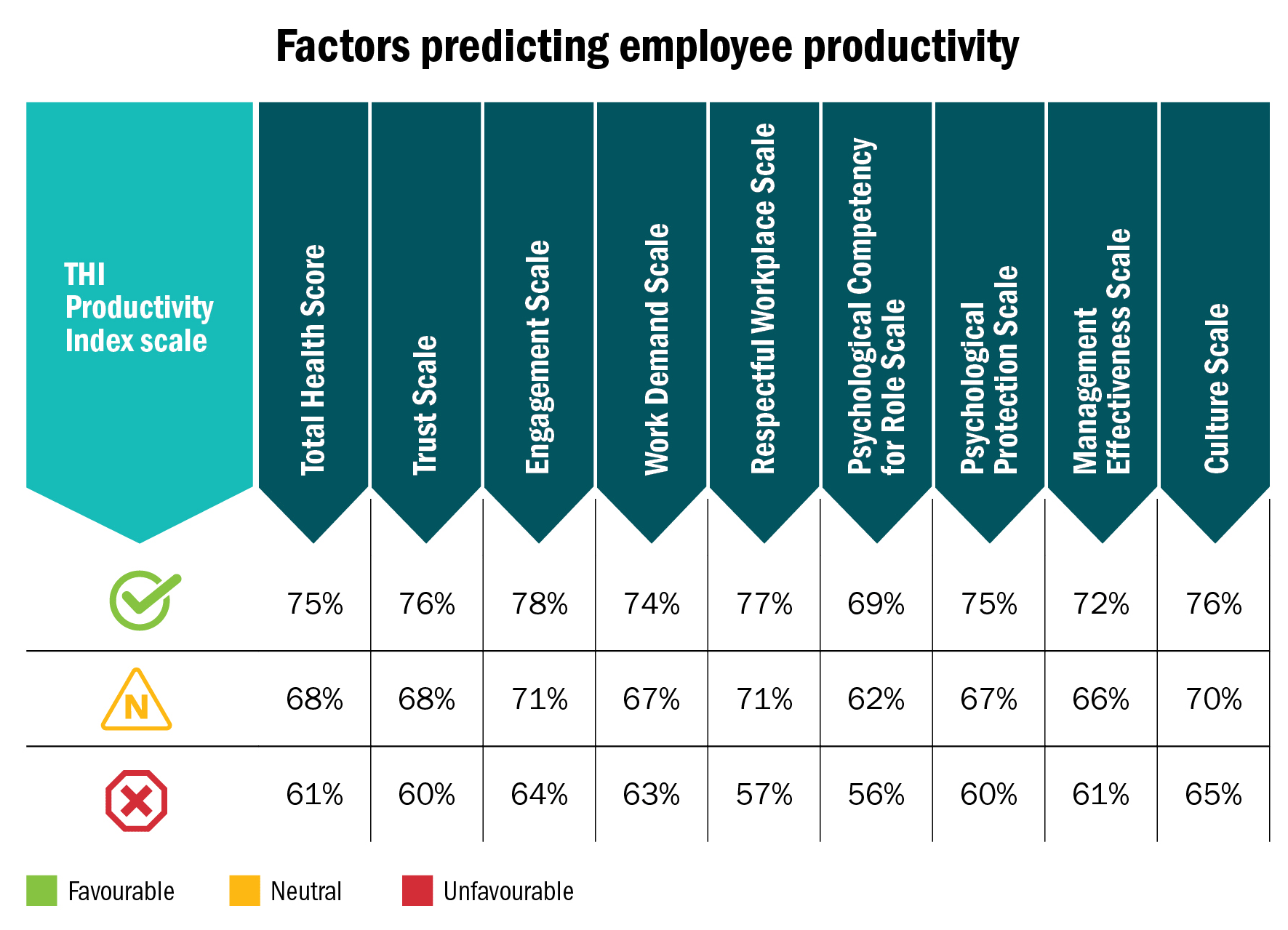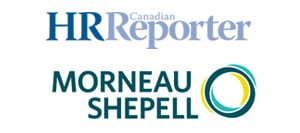The Total Health Index scale provides a baseline that can be measured year over year

Total Health Index (THI) research has provided Morneau Shepell with a framework for measuring employee productivity error, which defines the percentage of hours the average employee is fully engaged and productive.
This information gives senior leaders a baseline for both the financial cost of lost time (for example, sick time, discretionary effort and presenteeism) and lost productivity opportunity. Even a three per cent increase in full-time equivalent (FTE) productivity can be positive for enhancing financial results.
The THI productivity scale provides a baseline that can be measured year over year, like an engagement scale, productivity scale’s efficacy and predictive analytics capability can be improved when integrated with historical data such as: human resources information system (HRIS) documented days, short- and long-term disability time, and workers’ compensation days.
In 2017, the Organisation for Economic Co-operation and Development reported the average time worked per year by Canadian employees (full-time, part-time, part-year, including overtime) was 1,695 hours.
However, senior leadership cannot accurately measure employee productivity by simply measuring the number of hours the average employee works per week. This metric by itself is incomplete. An organization’s productivity can be defined by the total number of hours employees are willing and able to work to meet organizational expectations.
To do this with any accuracy, senior leadership requires an accurate baseline on three metrics: attendance, discretionary effort and presenteeism:
Attendance: Factors such as illness, family issues and mental health are a few examples of why a person takes time off work. Typically, these are covered under pay (such as a sick day bank, short- and long-term disability time and workers’ compensation claims) or leave without pay.
Discretionary effort: This is the amount of effort an employee willingly gives on a daily basis that goes above and beyond the minimal expectations for her assigned role. For example, if the average FTE at a 1,000-employee organization puts forth 80 per cent of her best effort daily, the other 20 per cent may not be productive. This suggests it is possible that up to 200 FTEs are not producing any tangible or measurable results. In this example, even a two per cent improvement in the average FTE’s discretionary effort could equal up to 20 more FTEs working to achieve measurable results.
Presenteeism: This can simply be defined as when an employee reports to work feeling unwell. The root cause can vary, from physical illness to mental illness, boredom, fear of bullying or chronic pain.
Suppose that Company ABC’s workforce planning schedule for its 1,000 employees means each employee is scheduled to work 37.5 hours per week for 48 weeks, 1,800 hours per year. Senior leaders who don’t have a lens to accurately measure the above three variables can’t accurately measure the organization’s employee productivity error.
THI productivity research has found that 53 per cent of employees fall in the favourable bucket, 33 per cent in the neutral bucket, and 24 per cent in the unfavourable bucket. This means 57 per cent of employees’ productivity scores are not optimal.
A profitable business that’s unaware of its employee productivity error could very well be producing good results that are still below its potential and are leaving money on the table. This suggests that a profit-and-loss statement (P&L) is not the only metric that can predict an organization’s potential to sustain revenue or grow.
To positively influence employee productivity error, leaders must be aware of the different kinds of levers involved, as seen in the above table. Employees reporting higher THI scores also have higher scores in multiple areas. These higher areas are levers that can positively or negatively affect employee productivity.
THI research continues to reinforce the theme that without health, there’s no chance to maximize employee engagement, and without engagement, there’s no chance to maximize productivity.
Coaching for HR
Here are some ways HR leaders can influence employee productivity:
Add employee productivity error to the HR scorecard: If you can’t define, observe or measure it, it’s difficult to make decisions to improve employee productivity. One starting place is to obtain an employee productivity error for the organization as a baseline metric (for example, 27 per cent). Using tools like THI or the Employee Recommended Workplace Award (www.employeerecommended.com/) allows an organization to obtain an evidence-based baseline for analyzing any relationships between HR metrics and financial metrics.
This provides a model to start to predict the tangible dollar impact the organization can obtain by improving its employee productivity error score (for example, benefit for moving from 27 per cent to 24 per cent). The employee productivity error metric can be used to evaluate how different initiatives such as policies, procedures and programs influence employee productivity error scores year over year.
Get CFO buy-in: Typically, when an organization’s CFO understands the math behind an employee productivity error productivity metric, and the link between that and dollars, he wants to work with HR to figure out how to lower financial risk and maximize productivity. Because CFOs, CEOs and boards (both for profit and non-profit) are constantly looking for variables that predict how an organization can achieve its financial results, having a metric that can support this eff ort can help to shape the business case for investing in employees to improve employee productivity error scores.
Bill Howatt, Ph.D., Ed.D., is the Toronto-based chief of research and development, workforce productivity, at Morneau Shepell. For more information and education about the company’s Total Health Index (THI), please visit the company’s website at www.morneaushepell.com.





